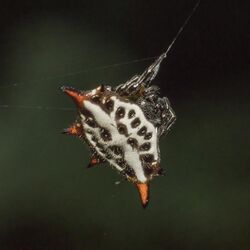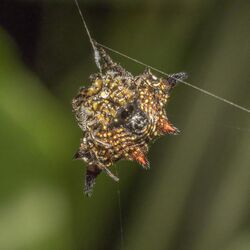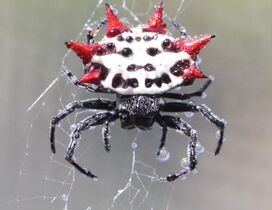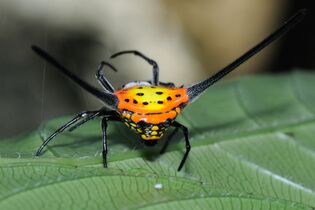Biology:Spiny orb-weaver
| Spiny orb-weaver | |
|---|---|

| |
| G. sanguinolenta dorsal side | |

| |
| G. sanguinolenta ventral side same spider, Príncipe island São Tomé and Príncipe | |
| Scientific classification | |
| Domain: | Eukaryota |
| Kingdom: | Animalia |
| Phylum: | Arthropoda |
| Subphylum: | Chelicerata |
| Class: | Arachnida |
| Order: | Araneae |
| Infraorder: | Araneomorphae |
| Family: | Araneidae |
| Genus: | Gasteracantha Sundevall, 1833[1] |
| Type species | |
| G. cancriformis (Linnaeus, 1758)
| |
| Synonyms[1] | |
| |
Gasteracantha (known as spiny-backed orb-weavers, spiny orb-weavers, or spiny spiders) is a genus of orb-weaver spiders first named by Carl Jakob Sundevall in 1833.[2] The females of most species are brightly colored with six prominent spines on their broad, hardened, shell-like abdomens. The name Gasteracantha is derived from the Greek gaster (γαστήρ), meaning "belly, abdomen", and akantha (άκανθα), meaning "thorn, spine".[3] Spiny-backed orb-weavers are sometimes colloquially called "crab spiders" because of their shape, but they are not closely related to the true crab spiders.[4] Other colloquial names for certain species include thorn spider,[5] star spider,[6] kite spider, or jewel spider.
Members of the genus exhibit strong sexual dimorphism. Males are several times smaller than females, and they lack prominent spines or bright colors.[4][5][7]
Gasteracantha is distributed worldwide in tropical and subtropical climates. The genus is most diverse in tropical Asia, from India through Indonesia.[1] One species, G. cancriformis, occurs in the Americas.[4] Gasteracantha species are related to spine-bearing orb-weavers in several other genera (see Taxonomy and Systematics).[8]
Orb-weavers' bites are generally harmless to humans.[9]
Taxonomy and systematics
Gasteracantha has a complex taxonomic history, and many questions of species limits and distribution and generic interrelationships remain unanswered. Furthermore, challenges include the variability within individual Gasteracantha species (e.g., color polymorphism and variable length and shape of spines), a lack of male specimens and descriptions for many species, missing or damaged type specimens, and ambiguous initial descriptions in 18th- and 19th-century scientific literature.[10] The 69 species currently recognized by World Spider Catalog include dozens of synonyms and subspecies, many based on literature well over 100 years old.[1]
Gasteracantha is related to several other spiny orb-weaver genera of Africa, Asia, and Australasia, many of which are monospecific:[8][10][11]
- Acrosomoides – 3 spp., Africa
- Actinacantha – Actinacantha globulata, Indonesia
- Aetrocantha – Aetrocantha falkensteini, central Africa
- Afracantha – Afracantha camerunensi, Africa
- Augusta – Augusta glyphica, Madagascar
- Austracantha – Austracantha minax, Australia
- Friula – Friula wallacei, Borneo
- Gastroxya – 4 spp., Africa
- Hypsacantha – Hypsacantha crucimaculata, Africa
- Isoxya – 16 spp., Africa, Madagascar, and Yemen
- Macracantha – 1 or 2 spp., Asia
- Madacantha – Madacantha nossibeana, Madagascar
- Parmatergus – 3 spp., Madagascar
- Thelacantha – Thelacantha brevispina, Australia, Asia, Madagascar
- Togacantha – Togacantha nordviei, Africa
A 2019 study examining three mitochondrial and two nuclear genes found that Gasteracantha is paraphyletic with respect to Macracantha, Actinacantha, and Thelacantha. M. arcuata is allied with G. hasselti and A. globulata, while T. brevispina is closer to G. kuhli and G. diardi. The authors, however, did not propose generic reassignments based on their findings.[10]
Micrathena orb-weavers in North and South America also have hardened abdomens with variously shaped spines, but they are not closely related to Gasteracantha within the orb-weaver family.[8]
G. hasselti
Krachan National Park, ThailandG. geminata
Lalbagh Botanical Garden, Bangalore, IndiaG. quadrispinosa
Queensland, AustraliaG. falcicornis
Mecúfi District, Mozambique
Species
(As of November 2021) Gasteracantha contains 69 species and 18 subspecies:[1]
- G. aciculata (Pocock, 1899) – Papua New Guinea (New Britain)
- G. acutispina Dahl, 1914 – Indonesia (Sulawesi)
- G. audouini Guérin, 1838 – Indonesia (Sumatra, Timor, Ambon), Philippines
- G. aureola Mi & Peng, 2013 – China
- G. beccarii Thorell, 1877 – Indonesia (Sulawesi)
- G. biloba (Thorell, 1878) – Indonesia (Moluccas, Ambon)
- G. cancriformis (Linnaeus, 1758) – North America, Central America, Caribbean, South America. Introduced to Hawaii
- Gasteracantha c. gertschi Archer, 1941 – USA
- G. clarki Emerit, 1974 – Seychelles
- G. clavatrix (Walckenaer, 1841) – Indonesia (Lombok, Sulawesi, Mentawai Is.)
- G. clavigera Giebel, 1863 – Thailand, Philippines, Indonesia (Sulawesi)
- G. crucigera Bradley, 1877 – Malaysia, Indonesia (Java, Borneo), New Guinea
- G. curvispina (Guérin, 1837) – West, Central Africa
- G. curvistyla Dahl, 1914 – Indonesia (Togian Is.)
- G. cuspidata C. L. Koch, 1837 – Malaysia, India (Nicobar Is.), Indonesia (Java)
- G. dalyi Pocock, 1900 – India, Pakistan
- G. diadesmia Thorell, 1887 – India to Philippines
- G. diardi (Lucas, 1835) – China, Thailand, Malaysia, Borneo, Indonesia (Sunda Is.)
- G. doriae Simon, 1877 – Thailand, Malaysia, Singapore, Indonesia (Sumatra, Borneo)
- G. falcicornis Butler, 1873 – Africa
- G. fasciata Guérin, 1838 – New Guinea, Guam
- G. flava Nicolet, 1849 – Chile
- G. fornicata (Fabricius, 1775) – Australia (Queensland)
- G. frontata Blackwall, 1864 – India, Myanmar, Thailand, Indonesia (Flores, Borneo)
- G. gambeyi Simon, 1877 – New Caledonia
- G. geminata (Fabricius, 1798) – India, Sri Lanka
- G. hecata (Walckenaer, 1841) – Philippines
- G. interrupta Dahl, 1914 – Indonesia (Lombok, Sulawesi)
- G. irradiata (Walckenaer, 1841) – Thailand to Philippines, Indonesia (Sulawesi)
- G. janopol Barrion & Litsinger, 1995 – Philippines
- G. kuhli C. L. Koch, 1837 – India to Japan, Philippines, Indonesia
- G. lepelletieri (Guérin, 1825) – Indonesia (Sumatra) to Philippines, New Guinea
- G. lunata Guérin, 1838 – Timor, Indonesia (Moluccas), New Caledonia
- G. martensi Dahl, 1914 – Indonesia (Sumatra)
- G. mediofusca (Doleschall, 1859) – Indonesia (Java), New Guinea
- G. mengei Keyserling, 1864 – Malaysia, Indonesia (Sumatra, Borneo)
- G. metallica (Pocock, 1898) – Solomon Is.
- G. milvoides Butler, 1873 – Central, East, Southern Africa
- G. notata Kulczyński, 1910 – Papua New Guinea (New Britain)
- G. panisicca Butler, 1873 – Myanmar to Philippines, Indonesia (Java)
- G. parangdiadesmia Barrion & Litsinger, 1995 – Philippines
- G. pentagona (Walckenaer, 1841) – Papua New Guinea (New Ireland, New Britain, Bismarck Arch.)
- G. picta (Thorell, 1892) – Singapore
- G. quadrispinosa O. Pickard-Cambridge, 1879 – New Guinea, Australia (Queensland)
- G. recurva Simon, 1877 – Philippines
- G. regalis Butler, 1873 – Vanuatu
- G. remifera Butler, 1873 – India, Sri Lanka
- G. rhomboidea Guérin, 1838 – Mauritius
- Gasteracantha r. comorensis Strand, 1916 – Comoros, Mayotte
- Gasteracantha r. madagascariensis Vinson, 1863 – Madagascar
- G. rubrospinis Guérin, 1838 – Indonesia (Lombok, Sulawesi, Moluccas), New Caledonia, Guam
- G. rufithorax Simon, 1881 – Madagascar
- G. sacerdotalis L. Koch, 1872 – New Guinea, Australia (Queensland), New Caledonia
- G. sanguinea Dahl, 1914 – Philippines
- G. sanguinolenta C. L. Koch, 1844 – Africa, Yemen (mainland, Socotra), Seychelles
- Gasteracantha s. andrefanae Emerit, 1974 – Madagascar
- Gasteracantha s. bigoti Emerit, 1974 – Madagascar
- Gasteracantha s. emeriti Roberts, 1983 – Seychelles (Aldabra)
- Gasteracantha s. insulicola Emerit, 1974 – Seychelles
- Gasteracantha s. legendrei Emerit, 1974 – Europa Is.
- Gasteracantha s. mangrovae Emerit, 1974 – Madagascar
- G. sapperi Dahl, 1914 – New Guinea
- G. sauteri Dahl, 1914 – China, Taiwan, Vietnam
- G. scintillans Butler, 1873 – Solomon Is.
- G. signifera Pocock, 1898 – Solomon Is.
- Gasteracantha s. bistrigella Strand, 1911 – Papua New Guinea (Bismarck Arch.)
- Gasteracantha s. heterospina Strand, 1915 – Papua New Guinea (Bismarck Arch.)
- Gasteracantha s. pustulinota Strand, 1911 – Papua New Guinea (Bismarck Arch.)
- G. simoni O. Pickard-Cambridge, 1879 – Central Africa
- G. sororna Butler, 1873 – India
- G. sturi (Doleschall, 1857) – Laos, Sumatra, Java, Borneo, Moluccas
- G. subaequispina Dahl, 1914 – Borneo, New Guinea
- G. taeniata (Walckenaer, 1841) – India to Polynesia
- Gasteracantha t. analispina Strand, 1911 – New Guinea
- Gasteracantha t. anirensis Strand, 1911 – Papua New Guinea (New Ireland)
- Gasteracantha t. lugubris Simon, 1898 – Solomon Is.
- Gasteracantha t. novahannoveriana Dahl, 1914 – Papua New Guinea (Bismarck Arch.)
- G. theisi Guérin, 1838 – Indonesia, New Guinea
- G. thomasinsulae Archer, 1951 – São Tomé and Príncipe
- G. thorelli Keyserling, 1864 – Madagascar
- G. tondanae Pocock, 1897 – Indonesia (Sulawesi)
- G. transversa C. L. Koch, 1837 – Indonesia (Sumatra, Java)
- G. unguifera Simon, 1889 – China, India
- G. versicolor (Walckenaer, 1841) – Central, East, Southern Africa
- Gasteracantha v. avaratrae Emerit, 1974 – Madagascar
- Gasteracantha v. formosa Vinson, 1863 – Madagascar
- G. westringi Keyserling, 1864 – Australia, Admiralty Is., New Caledonia
References
- ↑ 1.0 1.1 1.2 1.3 1.4 "Gen. Gasteracantha Sundevall, 1833". Natural History Museum Bern. https://wsc.nmbe.ch/genus/323/Gasteracantha. Retrieved 18 November 2021.
- ↑ Sundevall, C. J. (1833). Conspectus Arachnidum. Lund, Sweden. p. 14.
- ↑ "Genus Gasteracantha". BugGuide. https://bugguide.net/node/view/1982. Retrieved 2019-05-13.
- ↑ 4.0 4.1 4.2 "Species Gasteracantha cancriformis - Spinybacked Orbweaver". https://bugguide.net/node/view/2026. Retrieved 4 August 2019.
- ↑ 5.0 5.1 Williams, Steven. "Spiky Spiders". Oxford Museum of Natural History. https://morethanadodo.com/2016/06/13/spiky-spiders/. Retrieved 4 August 2019.
- ↑ Horwell, David; Oxford, Pete (August 2005). Galápagos Wildlife (2 ed.). Chalfont St Peter, Bucks SL9 9QE, England: Bradt Travel Guides Ltd. p. 26. ISBN 9781841621005.
- ↑ Sankaran, Pradeep M.; Jobi, Malamel J.; Sebastian, Pothalil A. (February 2015). "Redescription of the orb-weaving spider Gasteracantha geminata (Fabricius, 1798) (Araneae, Araneidae)". Zootaxa 3915 (1): 147-150. doi:10.11646/zootaxa.3915.1.10. https://biotaxa.org/Zootaxa/article/view/zootaxa.3915.1.10. Retrieved 4 August 2019.
- ↑ 8.0 8.1 8.2 Scharff, Nikolaj; Coddington, Jonathan A.; Blackledge, Todd A.; Agnarsson, Ingi; Framenau, Volker W.; Szűts, Tamás; Hayashi, Cheryl Y.; Dimitrov, Dimitar (23 April 2019). "Phylogeny of the orb‐weaving spider family Araneidae (Araneae: Araneoidea)". Cladistics. doi:10.1111/cla.12382.
- ↑ "Urban Spider Chart". https://entomology.ca.uky.edu/spider-chart#orb.
- ↑ 10.0 10.1 10.2 Tan, Ji; Chan, Zi Yang; Ong, Ching Ang; Yong, Hoi Sen (14 February 2019). "Phylogenetic relationships of Actinacantha Simon, Gasteracantha Sundevall, Macracantha Hasselt and Thelacantha Simon spiny orb-weavers (Araneae: Araneidae) in Peninsular Malaysia". Raffles Bulletin of Zoology 67: 32-55. doi:10.26107/RBZ-2019-0003. https://lkcnhm.nus.edu.sg/app/uploads/2018/11/RBZ-2019-0003.pdf. Retrieved 3 August 2019.
- ↑ Pickard-Cambridge, O. (1897). "On some new and little-known spiders (Araneidae).". Proceedings of the Zoological Society of London 64 (4, for 1896): 1006-1012. doi:10.1111/j.1096-3642.1896.tb03096.x.
External links
| Wikimedia Commons has media related to Gasteracantha. |
Wikidata ☰ Q2175752 entry







